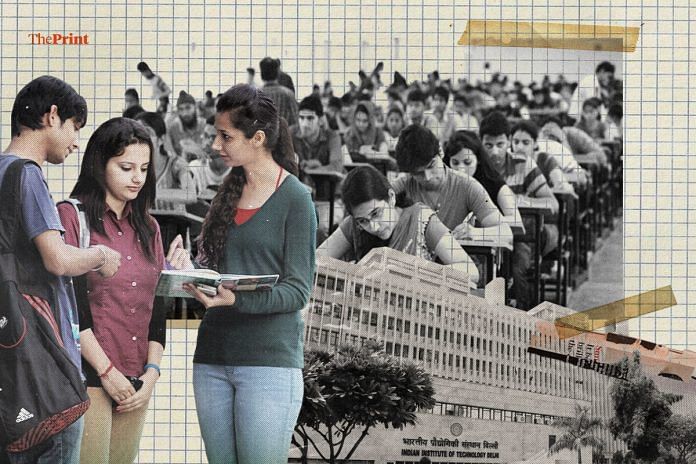The IITs this year have added 779 more seats for women. A large chunk of these seats are in mechanical and civil engineering, branches traditionally considered male-dominated. The move is aimed at balancing the gender gap in these branches.
Critics, however, argue that such a move will only lower the quality of engineers produced by the IITs.
ThePrint asks: Will IITs’ move to add more seats for women help bridge the gender gap in male-dominated engineering branches?
These fields are no longer about just working with machines or building dams
 V. Ramgopal Rao
V. Ramgopal Rao
Director, IIT Delhi
Traditionally, women have preferred ‘soft branches’ like computer science and electrical engineering. Very few choose mechanical or civil branches because the general perception is that these involve heavy machines and fieldwork.
However, these branches have evolved over time. For starters, more women are now teaching as faculty members in these branches. That is already a deviation from the tradition. If you’re a mechanical engineer, you don’t necessarily have to work with machines. It is all about automation now. You may be working primarily on a computer but still be a mechanical engineer.
Similarly, civil engineering is no longer just about building dams or bridges. There is a lot more focus on aesthetics, and even environmental sciences. A civil engineer could be a part of the building management of a large project.
We want people to realise that these fields aren’t what they used to be 50 years ago.
Women, especially, need to be aware of these changes. We want to encourage them to join these departments as it will add diversity and bring a gender balance.
After we started organising special counselling sessions for women looking to pursue an undergraduate degree, enrolment for women students went up from less than 10 per cent to over 16 per cent.
We are confident that this move will encourage more women to look at what kind of engineering careers they want to choose, differently.
Academic inclination, not reservation, should determine student’s choice
 Raghav Pandey
Raghav Pandey
Senior fellow, department of humanities and social sciences, IIT-Bombay
Before commenting upon the future of any policy adopted by the IITs, it is essential to contextualise the reasons which make these institutions immensely successful.
The IITs and the IIMs are the only educational institutes in this country, which find a mention at the global stage among institutes of excellence. The precise reason for this, which is often overlooked, is the autonomy of these institutes.
The IITs and the IIMs are completely autonomous from the University Grants Commission (UGC). This has helped these institutes escape routine bureaucratic and government control, which has contributed to their success.
The HRD and the Joint Seat Allocation Authority are looking to do exactly what has been avoided till now. The reservations for women in civil and mechanical engineering departments make absolutely no sense. The choice of selecting a department has to be organic and an individual decision, the institute or the government should not look to lure the students into choosing a branch.
The decision to choose a particular branch of engineering must be made by the student based on her aptitude. It should not be thrust upon her.
By deciding to reserve seats for women, we are not helping them – they would simply opt for the branch as they would get admission in it, and not because they are academically inclined to choose it. Also, this would come at a cost of someone who was academically inclined to pursue that stream.
Even parents need to realise that women can pursue these fields
 Putul Haldar
Putul Haldar
Assistant Professor, Civil Engineering department, IIT Ropar
Adding more seats for women is a welcome step. Although I don’t personally believe in gender biases, the step can help provide a plethora of opportunities to women.
Over the years, the dominance of men in engineering branches like mechanical and civil has reduced. I have worked in leading design firms and in the industry. Several of my college juniors (female) were pursuing mechanical engineering. The stereotype must go now.
Even parents need to realise that women can pursue these fields. During counseling, I receive countless emails from concerned parents. They are often worried about whether their daughters can, and should, pursue civil engineering.
Adding seats for women can help change that perception. It all depends on how a person is exposed to his/her field. Most people who study civil engineering fall in love with the subject and never deviate from it in the future.
Women not choosing these branches in the past could also be result of their personal choice – many women may not want to take up jobs that involve intense physical field work or use of heavy machinery.
Now, geotechical, structural and environmental engineering have opened up more avenues for women. This step by the IITs can help women embrace more opportunities. They will be able to set a positive precedent for the next generation of female students.
I didn’t pursue mechanical engineering since there was no girl in that branch
 Palak Chaudhary
Palak Chaudhary
Pursued engineering from GGSIPU
I was always interested in mechanical engineering but failed to secure a seat in an IIT. At the Guru Gobind Singh Indraprastha University (GGSIPU), I decided against pursuing mechanical engineering since I was the was only the girl in my batch who expressed an interest in the field.
Most girls who qualify engineering entrance tests opt for electrical or computer science branches. One of the reasons for doing this is the male-dominated job scenario in related sectors.
The step taken by the IITs will definitely motivate a lot of young women to opt for non-traditional branches of engineering. IITs are the most sought-after institutions of higher learning and I don’t think there should be any worry about seats not getting filled up.
IITs can start a trend where women go for non-traditional branches
 Kritika Sharma
Kritika Sharma
Special Correspondent
Traditionally, women have not chosen mechanical or civil branches of engineering. This is clear when one looks at the data from the All India Council for Technical Education, which manages the engineering institutes of the country.
The data shows that civil is the last preferred branch for women apart from mechanical engineering over the years. The reason is the nature of the job that comes with choosing these two branches. Women have shown more interest in branches such as computer science, electronics and electricals.
So, will the effort by IITs to add more seats for women to these two branches help fix the divide? Well, to an extent, it will. Even if there are just 23 IITs offering over 11,000 seats (a minuscule number compared to the thousands of engineering seats across the country), this decision is likely to start a trend where women go for non-traditional branches. And as experts say, this should work because the lines between various streams have been blurred in this day and age. A mechanical engineer does not necessarily need to go to a workshop or a civil engineer to a construction site. Most of the work has become automated.
Companies are also hiring experts in these fields for research-based jobs. A construction company, for example, has hired women PhD students from IIT-Mandi’s civil engineering branch this year.
Compiled by Deeksha Bhardwaj, journalist at ThePrint.






